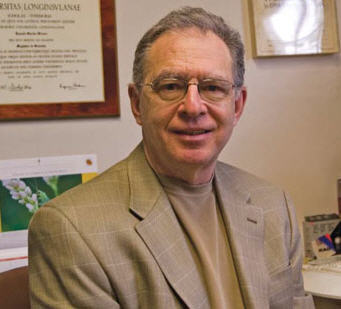|
||||||||||||||||
|

Ronald M. WeinerProfessor Emeritus Ph.D., Iowa State University, 1970
Research Interests: We are learning how prokaryotes adhere to, and colonize, marine surfaces. We are focusing on capsular exopolysaccharide (EPS) which may be a primary adhesion and which is a dominant component of marine biofilms. We most commonly study a paradigm, marine genus which we named Hyphomonas and which has species isolated from deep-sea hydrothermal vents. It's species have biphasic life cycles with a pelagic and adherent stage. This complex prokaryotic life cycle and its evolution and taxonomy have been elucidated by my laboratory. These bacteria tolerate a strikingly wide range of environmental conditions and have both autotrophic and heterotrophic capability. We are examining the molecular mechanisms and developmental cell biology that confer a potent survival advantage upon this taxon. We are using these mechanisms and biofilm probes that we have developed to screen for biofilm forming pathogens in the environment and on contaminated food products, in collaboration with Dr. S Joseph. As part of complex biofilms, we have investigated the way that periphytic bacteria signal invertebrates to colonize surfaces. We have shown that some Shewanella and Hyphomonas species synthesize enzymes involved in tyrosine degradation and oxidation and that a primary product, L-dihydroxyphenyl alanine (L-Dopa), can cue invertebrate set and enhance the integrity of biofilms. We have cloned the parahydroxy-phenyl-pyruvate oxidase (PHPPO) operon and isolated its product, homogentisic acid. The function and expression of PHPPO among diverse marine species has been determined. We are also studying enzymes that degrade relatively insoluble complex polysaccharides (CP) that are important in marine biofilms and marine plant and animal symbioses. These include cellulases, chitinases, agarases and alginases. We are learning about their expression, mode of action and role in inanimate surface or algal colonization. The laboratory is focusing on cell biological adaptations that optimize enzyme function. Briefly we have discovered that the marine bacterium, strain 2-40 (we proposed to name it to the genus, Microbulbifer), synthesizes complex structures that house, organize, and protect consortia of hydrolytic enzymes that bring to bear a concerted attack on the CP. This is very important because in terrestrial habitats, a specialized group of microorganisms degrade a significant portion of the more than 52 billion tons of cellulose that accumulate yearly by producing structures termed cellulosomes. These structures bind and organize the cellulolytic enzymes for a concerted attack on the CP, making the degradative process much more efficient. In the oceans, on the other hand, much less is known about how the annual production of the more than 25 billion tons of ICP, found in biofilms, associated with algae, and in invertebrate shells, is recycled to usable carbon. It turns out that 2-40 belongs to a recently discovered group of bacteria that includes degradative species such as shipworm symbionts, that recycle complex carbohydrates. 2-40, was isolated from decaying marine grass, Spartina, and appeared capable of single-handedly decomposing the plant. It was found to synthesize a battery of proteases, lipases, and at least 10 different enzyme systems that attack complex carbohydrates, including agarases, chitinases, alginases, pullulanases and laminarinases. The enzymes were best induced by the homologous substrate and their synthesis was repressed by glucose. Marine bacterium 2-40 was found, by scanning and transmission electron microscopy, to produce surface protuberances (termed hydrolysomes), when growing on complex carbohydrates but not when growing on simple sugars. Structurally the hydrolysomes resembled cellulosomes.The isolated hydrolysomes have potential applications in the bioremediation of biofouled surfaces, aquaculture wastes (e.g. shrimp and crab-shell) and plants efficiently recycling these to usable feedstock. They have medical applications as well. In collaboration with DOE, we sequenced the genome of 2-40. In collaboration with Dr. S. Hutcheson we have initiated a genome wide functional genomics and proteomics study. At least 150 open reading frames coding for CP depolymerases have been identified thus far. Of these, 22 have been identified as likely cellulases, cellobiases, or cellodextrinases and at least 7 identified as xylanases. Additionally, there are as many as 15 likely pectin lyases in the draft sequence. The completed draft sequence of the 2-40 genome enabled the first genome-wide analysis of a microbial chitinolytic system. The chitinase system of 2-40 was found to include secreted chitin depolymerases (ChiA, ChiB, ChiC), a secreted chitin binding protein (CbpA), periplasmic chitooligosaccharide modifying enzymes, putative sugar transporters, and a cluster of genes encoding cytoplasmic proteins involved in GlcNAc metabolism. Each chitin depolymerase was detectable in culture supernatants of chitin grown 2-40 and was active against chitin and glycol chitin. The agarase system was also examined to elucidate the constituent enzymes and functional domains. Several strategies, including genome analysis, revealed five enzymes apparently involved in the degradation of agar: AgaA, AgaB, AgaC, AgaD, AgaE. These all shared at least 40% similarity to a known agarase. The genes for these agarases were found dispersed within the 2-40 genome. Zymograms and thin layer chromatography of cloned AgaB and AgaF revealed that they are beta-agarases. The major product of AgaB activity is neoagarotretraose, indicating that it is a beta-agarase I. To our knowledge, M. degradans 2-40 is the first marine bacterium
shown to have a complete enzymatic system capable of completely
degrading all three of the major components of plant cell walls.
Based upon the number of its degradative enzyme systems, 2-40 appears
to be a versatile saprophyte and a significant participant in the
marine carbon cycle. Reviewed Publications 2004 - present
Weiner, R. 2004. The
Hyphomonas.
in: Bergey's
Manual of Determinative Bacteriology. 10th ed.,
Vol 3, Williams and Wilkins
Howard M, N
Ekborg, L Taylor, S Hutcheson and R Weiner.
2004. Genome-wide identification and analysis
polyserine linker domains in prokaryotes with emphasis on the
marine bacterium, Microbulbifer
degradans. J Protein Sci 13:
1422 –1425.
| ||||
|
|
|||||
|
